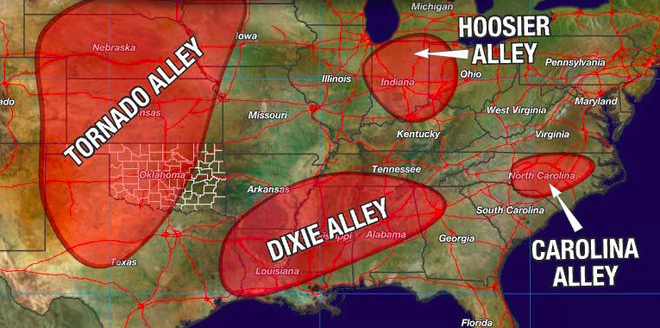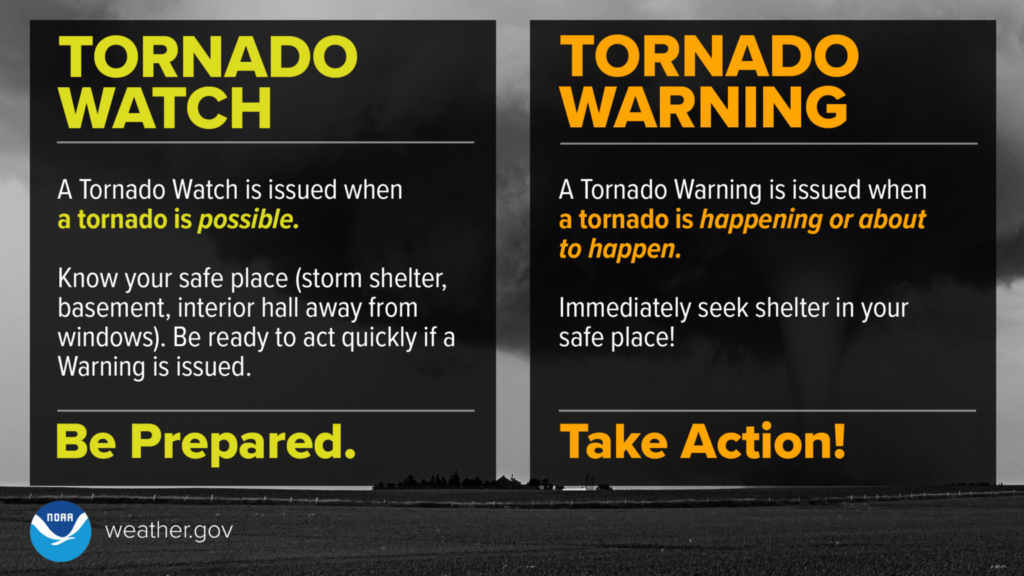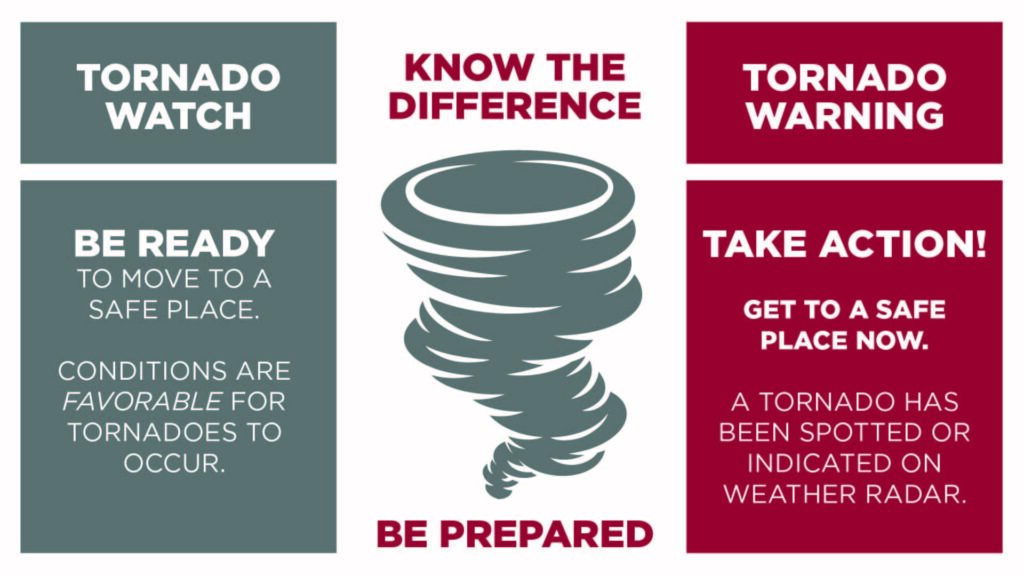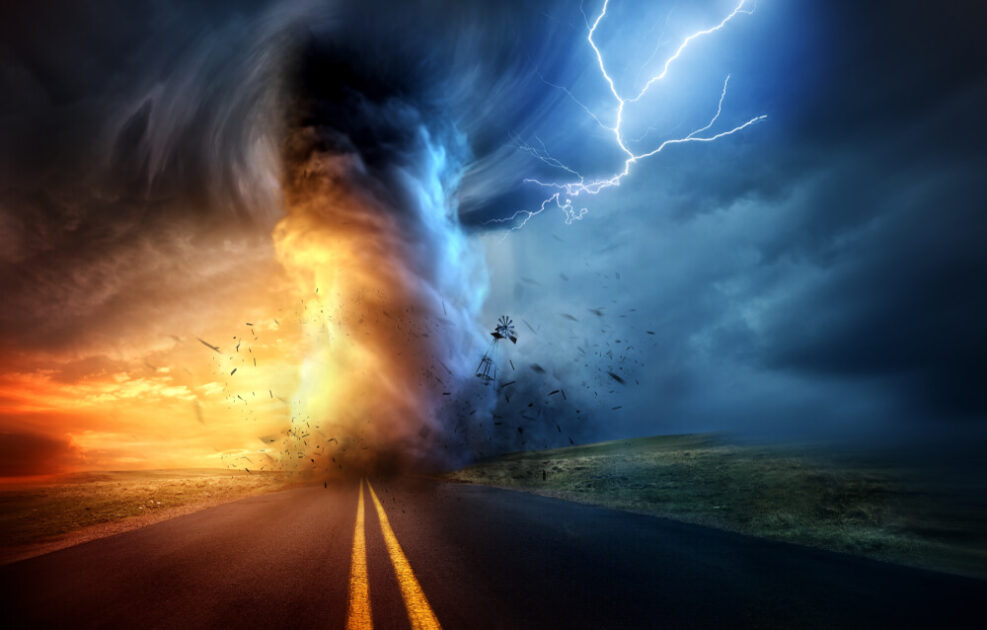Last Updated: March 20, 2024
March brings Severe Weather Preparedness Week and April is officially Tornado Awareness Month. Being prepared during tornado and storm season can mean the difference between life and death. Tornadoes can develop quickly and without warning, leaving little time to act fast and seek shelter. Having a plan in place ahead of time is essential. When a tornado strikes, wind speeds can reach 300 miles per hour, uprooting trees, buildings and structures while turning harmless objects into deadly projectiles, all in a matter of seconds. A tornado is spawned by a thunderstorm or a hurricane, and is essentially a violent windstorm characterized by a twisting, funnel-shaped cloud.

Carolina Alley Ranks 4th Deadliest Region
North Carolina ranks high amongst other states across the nation for tornado activity, with “Carolina Alley” the fourth deadliest region in the U.S. for tornados. This newest “alley” follows closely behind the more well-known Tornado Alley, Dixie Alley, and Hoosier Alley. It extends from northern Georgia, on a narrow path across South Carolina, and then follows along the path of the I-95 corridor into North Carolina. It’s important to remember that tornadoes can happen and have been reported in all fifty states! All parts of North Carolina can be affected by a tornado.
Peak tornado season in North Carolina runs from March through May, though tornadoes can occur at any time of year. According to North Carolina University, North Carolina has an average of about 29 tornadoes a year with the most active months being April and May.

Tips to Be Prepared for Tornado Season
1. Develop an Emergency Plan
Before entering the affected area, make sure it’s safe to do so. Turn off the power if necessary, and wear protective gear like gloves, boots, and a face mask.
Develop your emergency plan, communication plan, and make sure everyone knows when and where to seek shelter. A few seconds matter. Prepare an emergency kit that includes essential items such as water, non-perishable food, flashlights, batteries, a first aid kit, and a battery-operated radio.
2. Tornado Warning Signs
Know the difference between Tornado Watches and Warnings. WATCH means severe weather is possible. WARNING means severe weather is occurring; take shelter immediately.
3. Download Local and National Weather Apps and Alerts
Set up local weather alerts on your phone. Ensure you have easy access to NOAA Weather Radio or local radio or TV for the warning information. Public Warning Sirens are used in many towns to warn people of tornadoes.
4. Check Your Insurance Policy at Least Annually
Ensure you have adequate coverage at least once a year so you fully understand your policy, deductibles, and exclusions.
5. Annual Roofing & Exterior Inspections
We recommend getting annual inspections by a licensed general contractor to ensure your roofing, siding, and exteriors are structurally secure and sound. Undetected damage or leaks wreak havoc when a storm occurs.
6. Vetted Contractors
Have a list of preferred contractors available, including a 24/7 emergency services water/flood remediation company, licensed general contractor, roofing contractor, electrician, plumber.
Know the Difference Between a Tornado Watch and a Tornado Warning

What to Do Before A Tornado
1. Monitor Weather Alerts
Listen to your local weather alerts, NOAA Weather Radio or radio or television newscasts for the latest updates. In any emergency, always listen to the orders given by local emergency management officials. You may have just seconds of warning, if any.
2. Know the Danger Signs
Be alert to changing weather and storms and know the following danger signs:
- The sky may be very dark and even greenish.
- There may be a large, dark, low-lying cloud (particularly if rotating). Even if you can’t see a funnel, a cloud of debris can mark the place of a tornado.
- Large hail can be a warning sign, particularly during a Tornado Watch or Warning.
- Before a tornado hits, the wind may die down and the air may become very calm.
- You may hear a loud roar, much like a freight train.
- If you see oncoming storms or any of these danger signs, be ready to take shelter quickly.
3. Secure Your Property
Secure outdoor objects like lawn furniture and trash cans that may become dangerous projectiles during high winds.
4. Shelter Plan
- Indoors at Home: The safest place to be during a tornado is in a basement. If you have no basement, go to an inner hallway or smaller inner room without windows, such as a bathroom or closet. Go to the center of the room. Stay away from windows. Try to find something sturdy you can get under to shield you from flying debris and glass. Use your arms to protect your head and neck. Mobile homes are particularly open to damage from high winds. Go to a prearranged shelter when the weather turns bad.
- Shelter: If you’re away from home, seek out a basement, interior corridor, tunnel, underground parking lot or subway.
- While Driving: If you’re driving and see a funnel cloud or hear a Tornado Warning issued, get out of your vehicle and find safe shelter, preferably indoors. Do not try to outrun a tornado in a car. A tornado can toss cars, trucks and large SUVs around like toys. Do not stop under an overpass or bridge. If there is not an indoor shelter nearby, get out of your vehicle and lie down in a low area using your arms to cover the back of your head and neck. Be sure to stay alert for flooding.
- Outdoors: If no shelter is available and you’re outdoors, lie on the ground in a ditch or depression. Try to stay away from poles and overhead lines. Use your arms to protect your head and neck and wait for the storm to pass. While waiting, be alert for the flash floods that sometimes come with tornadoes.
What to Do After a Tornado
1. Check for Injuries
Check yourself and those around you for injuries. If someone is injured, seek medical attention immediately.
2. Stay Alert
Tornadoes can cause damage to buildings and structures, so be aware of any hazards that may be present, such as downed power lines or gas leaks.
3. Listen to Local Authorities and Weather Alerts
Follow any instructions given by local authorities, such as evacuation orders or curfews and further weather alerts.
4. Damage Assessment
Check your property and surrounding areas for damage. Take photos of any damage to document it for insurance purposes.
5. Contact Vetted Contractors
Contact a 24/7 emergency services water/ flood mitigation contractor if you have flooding or leaks. Contact a licensed general contractor for a roof and exterior inspection.
6. Contact Your Insurance Company
Contact your insurance company as soon as possible to report any damage and start the claims process.
7. Clean Up
If it is safe to do so, start cleaning up any debris around your property. Be
8. Take Care of Yourself
Tornadoes and storms can be devastating and traumatic, so be sure to take care of yourself and your mental health. Seek support from family, friends, or a professional if needed.
We Provide 24/7 Emergency Services! Contact National Restoration®️ North Carolina at 980-290-1913!
National Restoration North Carolina is a licensed general contractor and certified restoration contractor specializing in 24/7 emergency services, water, flood and mold remediation, remodeling, restoration, renovations and roof repairs and replacements. As a veteran-owned business, we have a team of experts available for 24/7 emergency response in the event of sudden leaks, floods, storms, tornadoes, hurricanes, or other perils. With over 20 years of experience, the most advanced accreditations and education, we’re your one-stop shop to get your property back to pre-loss condition. We serve homeowners and businesses throughout Union, Cabarrus, Mecklenburg, Stanly, Anson, Davidson, and Catawba Counties.
RESOURCES


